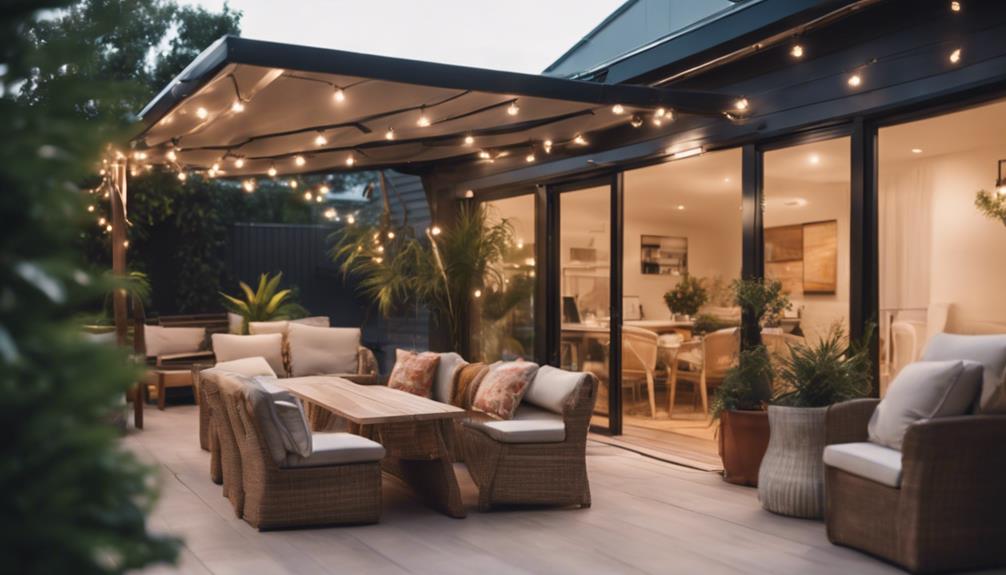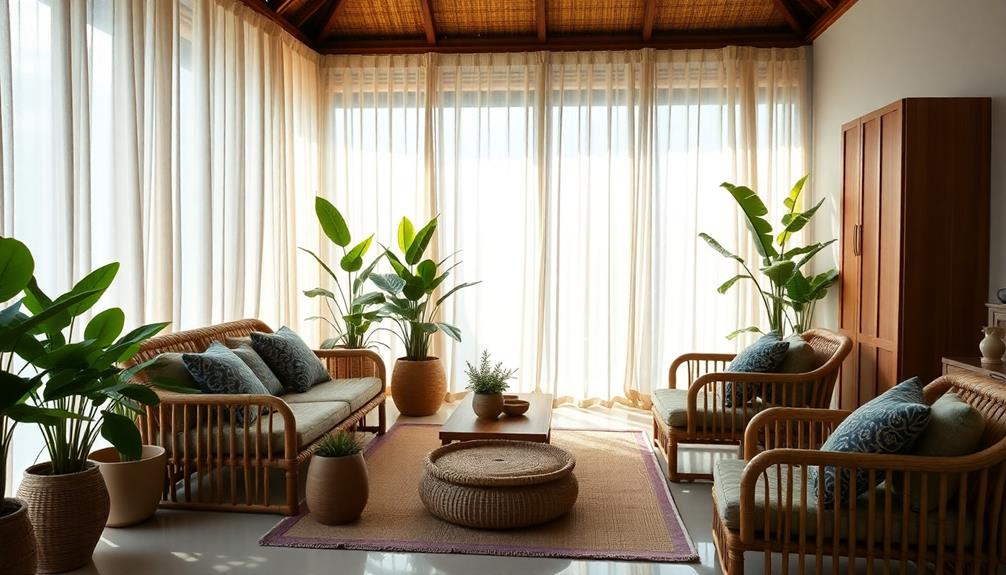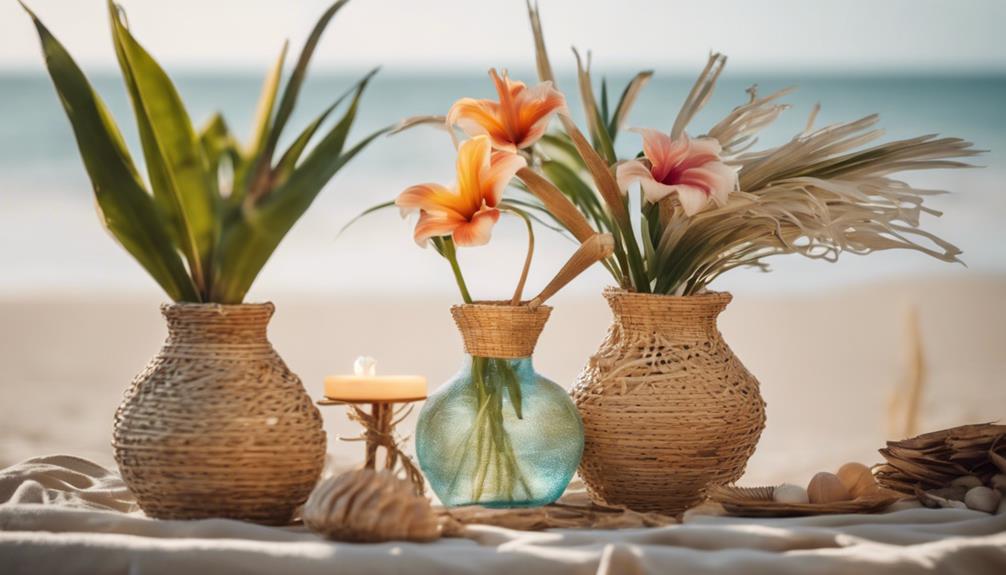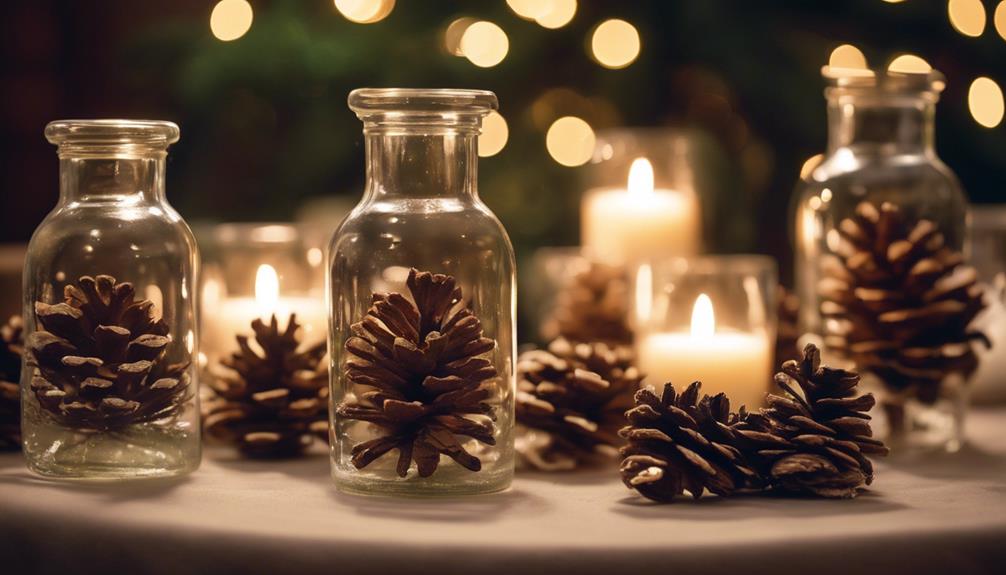To create your own DIY nest, start by gathering natural materials like twigs, grass, and moss, while drawing inspiration from different bird nests. Choose a location that mimics a bird's natural habitat, providing shelter and access to food and water. Weave the nest together using long, flexible stems, securing the foundation with natural materials. Test the nest's sturdiness by gently pressing and evaluating its weight capacity. Add decorative touches like colorful leaves or feathers to create a cozy environment. Finally, display your unique nest in a decorative tray or cloche, experimenting with heights and angles for visual interest – and that's just the beginning of your creative journey.
Key Takeaways
• Gather natural materials like twigs, grass, and moss, and observe bird nests for inspiration before collecting materials.
• Choose a location that mimics a bird's natural habitat, with shelter from harsh weather and access to food and water.
• Construct the nest by securely binding twigs, using long stems for the frame, and weaving materials tightly for insulation and protection.
• Test the nest's structural integrity, weight capacity, and resistance to environmental factors, and reinforce weak spots as needed.
• Add decorative elements like colorful leaves, flowers, or feathers to personalize the nest and create a cozy environment.
Gathering Materials and Inspiration
Gather natural materials like twigs, grass, leaves, and moss to get started on your DIY nest building project. You'll be amazed at how these simple elements can come together to create a beautiful and intricate nest.
As you collect your materials, take inspiration from the bird nests you observe in nature or online pictures. Notice the varying shapes and sizes, and think about the type of nest you want to build. Consider the size and shape of the nest you want to create before gathering materials, as this will help you determine the quantity of materials you'll need.
Take a cue from the birds in your area, and explore different types of nests they build. From intricately woven twig structures to cozy moss-lined cups, each nest is a reflection of the birds' remarkable engineering skills.
Choosing the Perfect Location
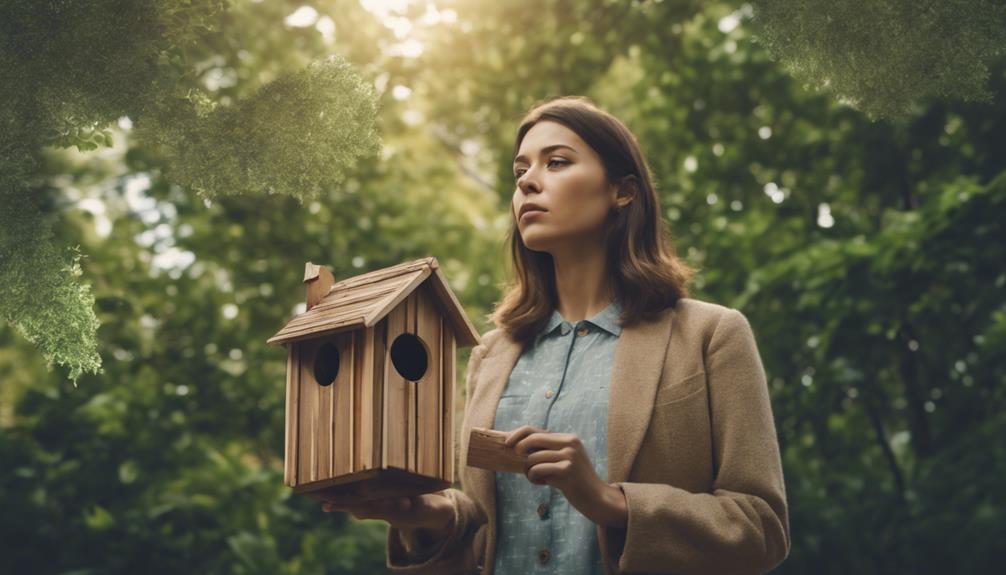
Now that you've gathered your materials and have a sense of the type of nest you want to build, it's time to think about where to place it. Choosing the perfect location is vital for attracting the right birds and ensuring they build a nest successfully.
To increase your chances of attracting birds, select a location that mimics the natural habitat of the species you want to attract. Make sure the nesting area is sheltered from harsh weather conditions like wind and rain. It's also essential to position the nest in a spot with easy access to food sources and water for the birds.
Avoid high-traffic areas where human or animal disturbances could disrupt the nesting process. Consider installing the nest at a height suitable for the bird species, ensuring safety from predators.
Weaving the Nest Together
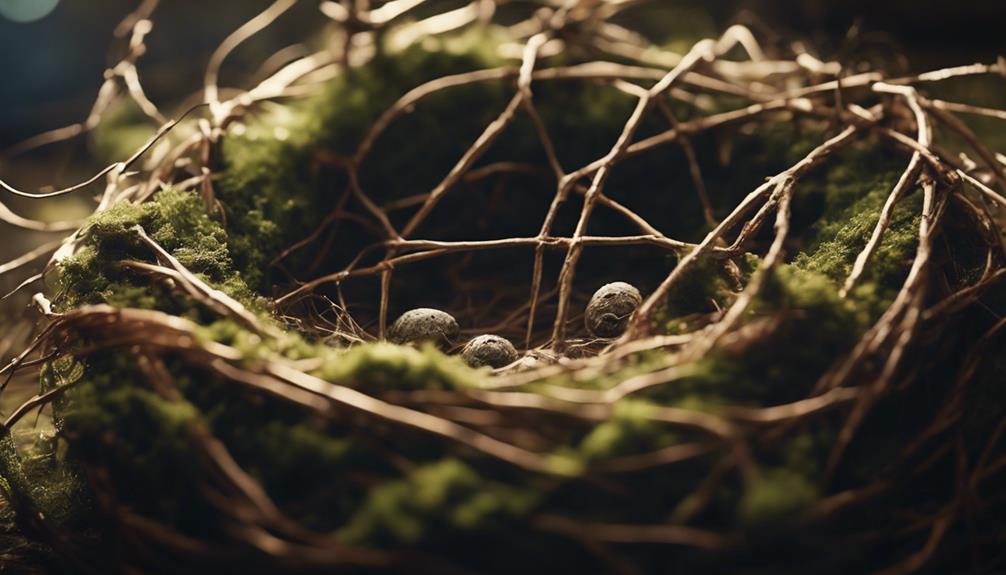
As you begin weaving your nest together, you'll need to focus on:
- Binding twigs together securely
- Assembling the frame of your nest
- Establishing a sturdy foundation
These essential steps will provide the structure for your DIY decorative nest, ensuring it's both visually appealing and durable.
Binding Twigs Together
You'll start weaving twigs together by selecting sturdy, flexible branches that will form the foundation of your nest.
As you begin binding twigs, remember that birds use this technique to create a vital foundation for their nests. By intricately weaving twigs, you'll form a secure structure that can withstand the weight of eggs and chicks. This essential step provides stability and durability to the nest, ensuring the safety of the eggs and hatchlings.
As you weave, keep in mind that twigs are an essential component in building a bird's nest. By properly binding twigs, you'll create a safe and comfortable space for bird nesting.
This intricate process requires patience and attention to detail, but the end result is well worth the effort. By following these steps, you'll be well on your way to creating a cozy and secure nest, just like birds do in the wild.
Nest Frame Assembly
With your sturdy twig foundation in place, gather long, flexible plant stems to shape the main frame of your nest. These stems will form the primary structure of your nest, so choose ones that are sturdy yet pliable.
To weave the nest frame together, bend the plant stems into a loop and secure them in place with twine or string. This will create the basic shape of your nest.
Next, add smaller loops and shapes to the nest frame by weaving in additional plant stems or branches. As you build, make sure to maintain a sturdy and well-shaped structure, as this will be the foundation of your nest.
Sturdy Nest Foundation
How do you plan to weave your nest together to create a sturdy foundation that will protect your eggs or young birds from the elements and predators? This vital step in DIY nest building requires careful consideration of the materials and techniques used.
By incorporating a variety of natural materials like twigs, grass, and leaves, you can create a strong and durable structure for your bird nest.
Here are some essential tips to keep in mind:
- Use a combination of flexible and sturdy materials to achieve the right balance of strength and flexibility.
- Weave the materials together tightly to prevent gaps and holes.
- Pay attention to the nest shape, ensuring it's deep enough to protect your eggs or young birds.
- Use weaving techniques that allow for good insulation and protection from the elements.
- Make sure the nest is well-anchored to prevent it from toppling over or being dislodged.
Testing the Nest's Sturdiness

As you test the nest's sturdiness, you're evaluating its structural integrity, weight capacity, and ability to resist environmental factors.
By gently pressing down on the nest, you'll determine if it can hold the weight of an egg without collapsing, a vital aspect of nest building.
A sturdy nest is one that can withstand wind, rain, and other harsh conditions, so it's imperative to get it right.
Nest Structural Integrity
You'll want to put your nest to the test by gently pressing down on it to check its sturdiness. This important step guarantees that your bird nest can withstand the elements and provide a safe haven for its future inhabitants. When testing the nest's sturdiness, you're verifying if it maintains its shape and structure when pressure is applied.
Here are some key takeaways to keep in mind:
- A sturdy nest will retain its shape when pressed upon, indicating proper weaving and material placement.
- The nest should securely hold its shape without collapsing or losing its form.
- If the nest collapses or loses its shape easily, it may need additional weaving or reinforcement.
- Ensuring the nest's sturdiness is essential for protecting eggs and providing a stable foundation for bird nesting.
- Building nests that can withstand the elements requires careful attention to detail and a focus on structural integrity.
Nest Weight Capacity
To determine your nest's weight capacity, place weighted objects like eggs or small rocks inside the nest, gradually increasing the weight to test its importance. This critical step guarantees that your nest can support the weight of birds and their offspring without collapsing or losing its shape.
As you're building your nest, keep in mind that birds can build their nests to last, and yours should be no exception. When you make a bird nest, it's crucial to take into account the weight capacity to attract birds and make sure the nest's functionality.
Observe how the nest reacts to different weights to gauge its durability. You can use a bucket or container to hold the weighted objects during testing. As you add more weight, pay attention to any signs of strain or weakness in the nest's structure. A sturdy nest that can hold objects without breaking is crucial for its success.
Resisting Environmental Factors
Now that you've confirmed your nest can support the weight of its inhabitants, it's time to test its sturdiness against environmental factors that could threaten its structure. As a DIY nest builder, resisting environmental factors is vital to make sure your birds nest remains safe and cozy.
To evaluate your nest's sturdiness, follow these essential steps:
- Gently press on the nest to see if it holds its shape.
- Check for loose or weak spots that may need reinforcement.
- Make sure the nest can withstand mild environmental factors like wind or light pressure.
- Evaluate the nest's resilience by lightly shaking it to see if the structure remains intact.
- Consider using additional materials or techniques to enhance the nest's durability against environmental factors.
Adding Decorative Touches
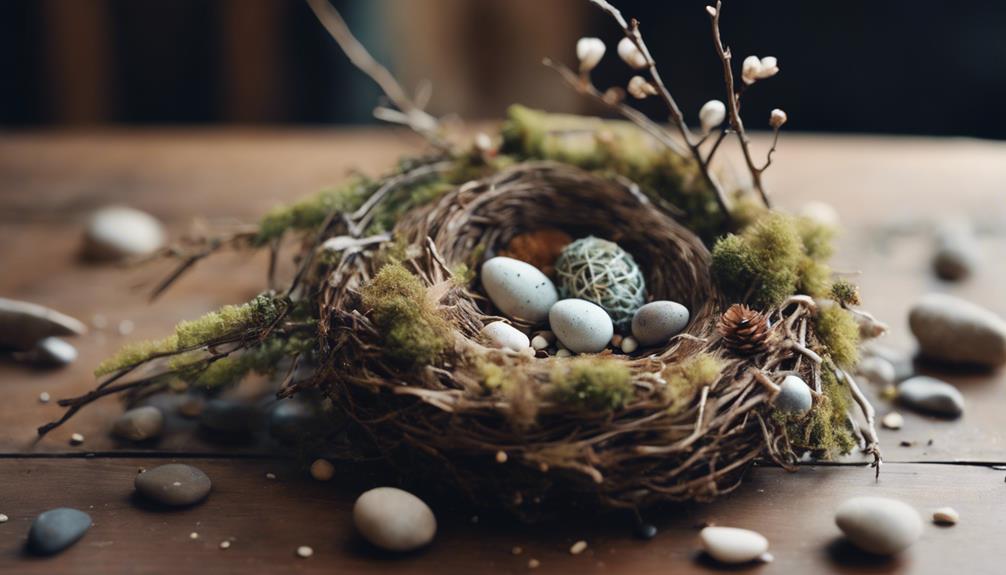
With a solid foundation in place, it's time to elevate your nest's aesthetic appeal by incorporating decorative touches that reflect your personal style.
You can make your nest truly unique by experimenting with various textures and colors. For instance, you can add some green moss to give it a natural, earthy feel, similar to what some bird species use to make nests.
To add an extra layer of realism, you can place eggs inside the nest, which will give it a cozy, inhabited look. Decorative touches like feathers, bark, and other natural materials can enhance the visual appeal of your nest, making it a beautiful piece of art.
By incorporating these elements, you can create a visually appealing decorative nest that showcases your creativity and attention to detail.
Completing and Displaying the Nest
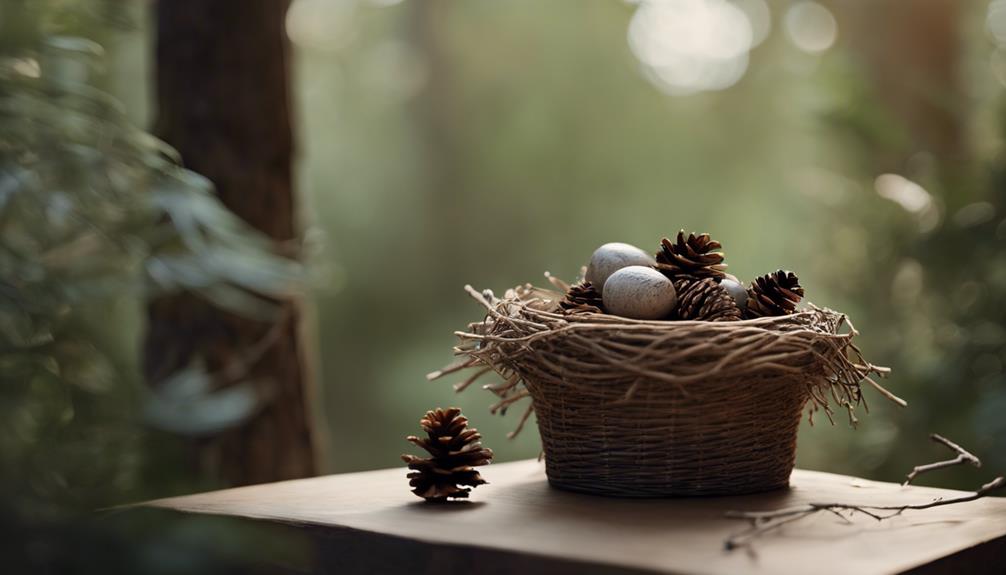
You've invested time and creativity into building a unique nest, and now it's time to showcase your masterpiece by displaying it in a way that highlights its beauty and charm. A well-designed display can elevate your nest from a simple craft project to a stunning work of art.
Here are some ideas to get you started:
- Consider placing your nest on a decorative tray or in a cloche to add an extra layer of elegance.
- Experiment with different heights and angles to create visual interest.
- Add some natural elements, like pinecones or twigs, to bring the outdoors in.
- Create a themed display by incorporating seasonal decorations, like holly or ornaments, around your nest.
- Don't be afraid to think outside the box (or nest!) and try displaying your nest in a unique way, like on a handmade cake stand or with farmhouse elements for a rustic look.
Frequently Asked Questions
How Do You Make Your Own Nest?
You're wondering how to make your own nest?
Start by gathering long, flexible plant stems to form the main shape. Bend and tie them into a loop, then add smaller loops to shape the rest of the nest.
You can decorate it with feathers, bark, moss, and other scavenged materials to give it a cozy touch.
How Do You Make a Nest for Yourself?
Are you thinking, 'What's the point of making a nest for myself?'
Well, creating a cozy nook can be a therapeutic escape from the world.
To make a nest for yourself, start by identifying a quiet, comfortable spot, like a corner of your bedroom or a secluded outdoor area.
Then, gather materials like blankets, pillows, and soft fabrics to create a snug, inviting space that's all yours.
How Do You Make a Simple Nest for Kids?
When creating a simple nest for kids, you'll want to gather natural materials like twigs, grass, and leaves. Collect these materials in a bucket or container, and encourage kids to observe nearby bird nests for inspiration.
Building the nest on a tray makes it easy to work indoors, or you can take the activity outside. Once built, test the nest's sturdiness by placing small rocks or eggs inside.
How to Build a Bird Box Step by Step?
As you start building a bird box, remember that it's not just about providing a cozy home for your feathered friends, but also about creating a safe haven that mimics their natural habitat.
To get started, choose the right materials, such as wood, screws, and waterproof paint, and measure the wood pieces according to the species you want to attract.
Conclusion
As you step back to admire your handiwork, the nest's natural nuances nestled among the branches, you'll notice the intricate interplay of twigs, leaves, and feathers.
Softly swaying in the breeze, the nest's sturdy structure shines, a confirmation of your patient persistence.
With each delicate detail deliberately designed, your DIY masterpiece is now a cozy, calming sanctuary, waiting to cradle its new inhabitants.

